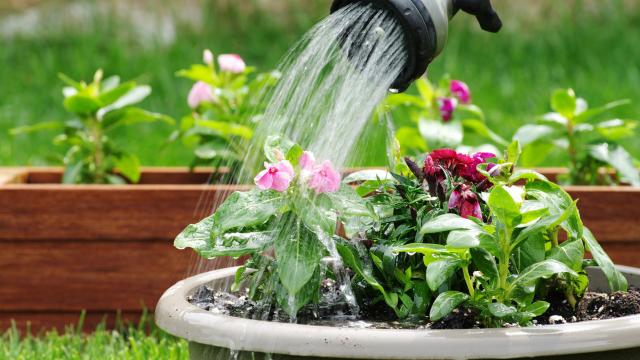If you live somewhere with all four seasons (or probably more realistically, two: summer and winter), you may look forward to growing outdoor plants once the weather warms up. But things can get tricky if there’s not enough rain. In places that are experiencing a dry spell, there are a few things you can do to keep your outdoor plants alive — and yes, they involve water.
How to tell if your plants are thirsty
Guidelines from the University of California’s department of agriculture and natural resources note that symptoms of water stress include:
- Wilting or drooping leaves that do not return to normal (without additional water) by morning
- Curled or yellow leaves that may fold or drop, along with potential twig drop
- Leaves that lose lustre and become grayish or bluish
- Sunburned leaves (especially on the south side of a tree)
- New leaves that are smaller or stem sections that are closer together than normal
- Lawn grasses that retain a footprint for several minutes
If any of this sounds familiar, you may need to rethink your summer gardening strategy.
Tips for helping your outdoor plants alive
Instead of just taking a hose and over-watering your lawn, plants and flowers, here are a few strategies from the Gardener’s Journal:
- Water deeply, but infrequently. This means that a deep soak once a week is better than sprinkling the plants every day, because it encourages deep roots and helps flush any salt build-up in the soil.
- Apply water directly to the soil, using drip irrigation, AquaCones, a tree bag or a soaker hose. Using these methods, less water will be lost to evaporation, compared to when you water from above. You may also want to use self-watering containers to provide a slow, steady supply of water to roots.
- Mulch can help. Specifically, put down a 2″ to 3″ layer of bark mulch, shredded leaves or pine straw to help keep the moisture in and insulate the soil. And mulch isn’t only for flowerbeds: you can use it on container plantings, too.
- It may seem counterintuitive, but stop fertilizing. When you do this, it encourages the plant to grow, and the more a plant grows, the more water it needs.
- Don’t heavily prune trees and shrubs, because it also stimulates new growth.
This should help give your plants a fighting chance during periods of little or no rain.

Leave a Reply
You must be logged in to post a comment.